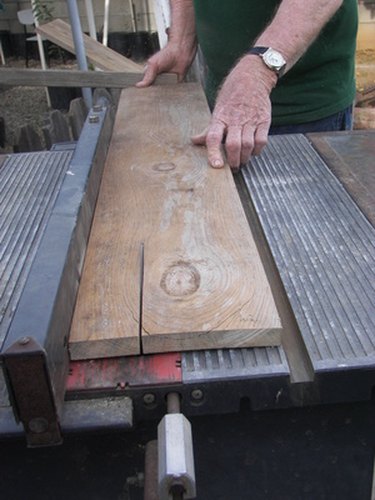
The furniture manufacturing industry has been revolutionized over the past several decades. Today, most commercial and production furniture is created by large machinery, much of it automated and controlled by computer. The prevalence of high-tech machinery increases the accuracy and speed of manufacture, but also removes much of the craftsmanship involved. When used well, and with high-quality materials, machines can make solid and attractive furniture.
Jointers, Planers, and Edgers
Video of the Day
Rough lumber is flattened, smoothed, and processed to exact dimensions using jointers, planers, and edgers. Jointers take the warp and bend out of the bottom of a board so that it will lie flat when it goes through the planer. Planers flatten the top of a board, and cut it down to the desired thickness. Edgers take the rough wood and any warp or bend off the sides of a board. High production facilities often combine these functions in single multi-purpose machines that are able to joint, plane, and edge in a single pass.
Video of the Day
Table Saws
Table saws range in size from portable units that can be used on a job site to multi-ton behemoths that are able to slice through any size of wood. Smaller and home-use saws run on 110 or 220 volts, while larger industrial saws often use three phase motors or 440 volts. Laser guides and power feeds speed up and automate the processing of wood on industrial wood saws.
CNC Routers
CNC stands for Computer Numerical Control. CNC routers are used extensively in the modern furniture industry to cut coves, mortises, and slots, and to do a wide variety of shaping tasks. The desired shape is entered into the computer, and the router is then robotically manipulated by the machine rather than a human being. CNC routers can work both wood and metal.
Sanders
Stationary sanders are made of one, two, or more large rotating belts with a feed table beneath them. Wooden panels can be fed through them in order to sand the surfaces of the wood and to smooth out glue joints. The thickness of the panel is determined by raising the feed table up toward the sanding belts for a thinner panel. Double-headed sanders have a heavier grit belt followed by a finer grit belt, enabling rough and finish sanding in a single pass.
Finishing Booths
Finishing booth are areas in furniture factory where protective finishes such as polyurethane are sprayed onto the furniture as a final step in its manufacture. Finishing booths are usually sealed off from the rest of the shop and equipped with fans to draw fumes away from the worker. Even with the best air filtration systems, employees who work in the finishing booth must wear high quality respirators. Spray finishing is far faster than hand finishing, and when done properly leaves an attractive and durable finish.